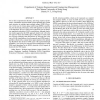Free Online Productivity Tools
i2Speak
i2Symbol
i2OCR
iTex2Img
iWeb2Print
iWeb2Shot
i2Type
iPdf2Split
iPdf2Merge
i2Bopomofo
i2Arabic
i2Style
i2Image
i2PDF
iLatex2Rtf
Sci2ools
ICASSP
2009
IEEE
2009
IEEE
On the performance of semidefinite relaxation MIMO detectors for QAM constellations
Due to their computational efficiency and strong empirical performance, semidefinite relaxation (SDR)–based algorithms have gained much attention in multiple–input multiple–output (MIMO) detection. In the case of a binary phase–shift keying (BPSK) constellation, the theoretical performance of the SDR approach is relatively well–understood. However, little is known about the case of quadrature amplitude modulation (QAM) constellations, although simulation results suggest that the SDR approach should work well in the low signal–to–noise ratio (SNR) region. In this paper we make a first step towards explaining such phenomenon by showing that in the case of QAM constellations, several commonly used SDR–based algorithms will provide a constant factor approximation to the optimal log–likelihood value in the low SNR region with exponentially high probability. Our result gives some theoretical justification for using SDR–based algorithms for the MIMO detection of QAM s...
Related Content
| Added | 21 May 2010 |
| Updated | 21 May 2010 |
| Type | Conference |
| Year | 2009 |
| Where | ICASSP |
| Authors | Anthony Man-Cho So |
Comments (0)

